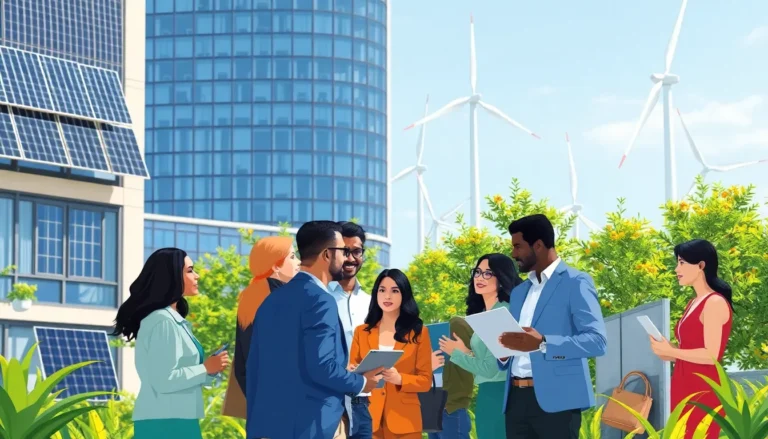In a world where gadgets seem to have a mind of their own, tech innovation stories are the tales that keep us on the edge of our seats. From self-driving cars that might just be better at parallel parking than most humans to smart fridges that can judge your late-night snacking habits, these stories are more than just bytes of information; they’re the heartbeat of our digital age.
Imagine a time when the idea of talking to your home assistant felt like science fiction. Now, it’s as common as asking your neighbor for sugar. These innovations aren’t just reshaping our lives; they’re redefining what’s possible. Buckle up as we dive into the fascinating world of tech innovation, where creativity meets technology and the future is just a click away.
Table of Contents
ToggleOverview of Tech Innovation Stories
Tech innovation stories reflect how technology evolves and impacts daily life. Each story showcases unique advancements shaping society’s future. Self-driving cars, for instance, illustrate transport’s transformation, enhancing safety and efficiency. Smart fridges represent another leap, integrating connectivity and energy savings into kitchen appliances.
Innovators play a critical role in these developments. Visionaries push boundaries, introducing concepts once deemed impossible. Companies invest in research and development, ensuring continuous growth in various sectors. For example, startups focusing on artificial intelligence explore ways to enhance decision-making across industries.
The influence of these innovations extends beyond individual benefits. Society experiences shifts in job markets and education due to technological integration. Online learning platforms have emerged, providing unprecedented access to knowledge and skills. Remote work tools empower individuals to collaborate across distances, redefining workplace norms.
Environmental impacts also surface through innovative technologies. Companies prioritize sustainability while developing new products. Renewable energy solutions increasingly gain traction, offering cleaner alternatives to traditional energy sources. Electric vehicles represent a significant stride toward reducing carbon footprints.
Tracking these advancements reveals patterns and trends central to understanding tech’s future. Tech blogs and news outlets often spotlight breakthroughs and their societal implications. Readers can explore these narratives to grasp how innovation shapes their environment. Each story contributes to a broader understanding of the pace and direction of technological progress.
Groundbreaking Innovations

Innovations in technology continue to redefine various aspects of life, showcasing remarkable advancements across numerous fields.
Case Study: Artificial Intelligence
Artificial intelligence (AI) drives transformative changes in industries. Companies leverage machine learning algorithms to enhance decision-making processes and improve customer experiences. These AI systems analyze vast data sets quickly, enabling businesses to personalize services effectively. Automation through AI also optimizes operational efficiency, reducing costs significantly. For instance, AI-powered chatbots handle customer inquiries, offering 24/7 assistance and decreasing wait times. The implementation of AI in healthcare leads to improved diagnostics and patient care, showcasing its potential. As organizations invest in AI, the technology continually evolves, promising a future where human capabilities are augmented and enhanced.
Case Study: Renewable Energy
Renewable energy emerges as a pivotal solution to environmental challenges. Innovations in solar and wind technologies contribute to cleaner energy production, significantly reducing dependence on fossil fuels. Solar panels for homes and businesses generate electricity sustainably, while wind turbines harvest energy efficiently. The growth of electric vehicles correlates with advancements in battery technology, providing longer ranges and faster charging. These developments drive down carbon footprints, supporting global sustainability objectives. Additionally, governments and private sectors increasingly collaborate to enhance renewable energy infrastructure, creating a shift towards greener energy solutions. The impact of renewable energy technologies reaches far beyond energy consumption, fostering economic growth and environmental preservation.
Impact on Society
Tech innovations significantly alter society in various dimensions. They create new economic prospects while reshaping social interactions.
Economic Benefits
Technology boosts productivity across industries. Automation reduces labor costs, enabling companies to allocate resources more efficiently. For instance, businesses utilizing AI-driven analytics enhance operational performance, leading to lower expenses. Job creation in tech sectors further stimulates economic growth. Remote work solutions generate flexibility, allowing organizations to hire talent globally. This connective capability results in diverse workforces that foster creativity and innovation. As businesses adapt to digital landscapes, they reduce overhead costs through streamlined processes. Small start-ups gain access to advanced tools that democratize opportunities, promoting competition.
Social Changes
Innovations transform communication, enabling instant connections. Individuals leverage technology for social interactions, bridging geographical divides. Online platforms encourage collaboration, empowering communities to engage on pressing issues. Smart devices facilitate access to information, increasing awareness about global challenges. Remote learning expands educational access, offering resources to underserved populations. Additionally, social media fosters the rapid spread of ideas and movements, influencing public discourse. Technology enhances daily life by personalizing experiences, creating connections that enrich relationships. Finally, through advancements in health technology, individuals manage well-being more effectively, supporting healthier lifestyles and better care outcomes.
Future Trends in Tech Innovation
Tech innovation continues to shape the future profoundly. New technologies emerge constantly, presenting opportunities for advancements across various sectors.
Emerging Technologies
Innovations in artificial intelligence, blockchain, and quantum computing capture significant attention. AI enhances personalization in customer experiences, driving efficiency and decision-making. Blockchain improves security and transparency in transactions, reshaping industries like finance and supply chain. Quantum computing, though still developing, holds the potential to solve complex problems that classical computers can’t. Industries are investing heavily in these technologies, aiming for greater operational success and competitive advantage.
Predicting the Next Big Breakthrough
Forecasting future breakthroughs in technology involves analyzing current trends and research. Experts anticipate innovations in areas like biotechnology and augmented reality. Biotech advancements promise new medical treatments and improved agricultural practices. Augmented reality offers immersive user experiences, transforming fields such as education and entertainment. Collaboration among startups, researchers, and established companies accelerates innovation, leading to rapid development of groundbreaking solutions. Companies focusing on these areas are likely to redefine markets, transforming how people live and work.
Tech innovation continues to reshape the world in profound ways. As advancements in artificial intelligence renewable energy and automation emerge they create new opportunities and challenges. The stories of self-driving cars smart fridges and groundbreaking technologies illustrate a future where convenience safety and sustainability are paramount.
Engaging with these narratives not only highlights the transformative potential of technology but also underscores the importance of collaboration among innovators. As society navigates this evolving landscape staying informed and adaptable will be crucial. Embracing these changes can lead to a more connected efficient and sustainable future for everyone.










